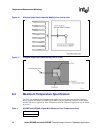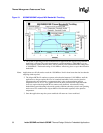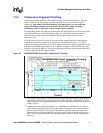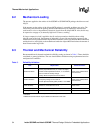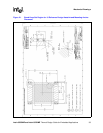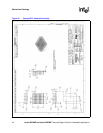
Intel
®
855GME and Intel
®
852GME Thermal Design Guide for Embedded Applications 33
Thermal/Mechanical Applications
Thermal/Mechanical Applications 8
8.1 Thermal Interface Materials
Use of a Thermal Interface Material (TIM) between the chipset MCH package and the thermal
enhancement is highly recommended to reduce the thermal resistance between the package and the
thermal enhancement device. A reduction in the thermal resistance at this interface creates a larger
effective thermal conductivity through the interface that improves the thermal capability of the
package.
Common types of interface materials include elastomers and phase change materials. These types
of materials can easily conform to fill small air gaps that are left between the two interfaces that are
mated together. These air gaps can act as insulators and will increase the thermal resistance. An
interface material can assist in filling these voids and reducing the thermal resistance at the
interface. The total thermal resistance through the interface would consist of the three main
resistances:
1. Thermal interface material resistance (θ
TIM
)
2. Contact resistance between the top of the chipset MCH package and the bottom of the thermal
interface material (θ
contact-top
)
3. Contact resistance between the top of the thermal interface material and the bottom of the heat
spreader or heat sink (θ
contact-bottom
)
8.1.1 Estimate Thermal Resistance
The thermal resistance of a material can be estimated by using the expression in Equation 1.
The expression provides a result in units of ºC/W. If adequate force is applied onto the thermal
interface material, it can be assumed the contact resistances are negligible. This is a valid
assumption when using the reference design described in Section 4.
θ
TIM
= Thermal Resistance through the material (ºC/W)
L = thickness of the material (m)
k = thermal conductivity of material (W/m-ºC)
A = cross sectional area of the material (m
2
)
Equation: Thermal resistance of a material
kA
L
TIM
=
θ




